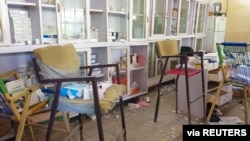A new Human Rights Watch report calls for an independent investigation into alleged shelling of civilian areas in the Tigray region by Ethiopia’s federal forces.
“Artillery attacks at the start of the armed conflict struck homes, hospitals, schools, and markets in the city of Mekelle, and the towns of Humera and Shire, killing at least 83 civilians, including children, and wounding over 300,” said the report, released Thursday.
HRW said it spoke to over 30 witnesses, examined satellite imagery, and reviewed photographs and videos of the attacks in Humera, Shire, and Mekelle. It said the shelling could be a violation of the laws of war.
The Ethiopian government said it conducted precision strikes to recapture cities in the hands of the Tigrayan People’s Liberation Front (TPLF), the regional armed group and former ruling party. The government accused the TPLF of defying a decision to postpone elections last year and of attacking a federal army base.
Prime Minister Abiy Ahmed said no civilian was harmed in what he termed a “law enforcement operation” which began in early November.
The HRW report comes as aid groups raise concerns about the dire conditions in rural areas of Tigray and lack of humanitarian access outside the main cities.
Francesco Rocca, the president of the International Federation of Red Cross and Red Crescent Societies (IFRC) recently visited the capital city of the Tigray region, Mekelle. He said conditions at local medical facilities were concerning.
“I visited two hospitals and they have no patients in because they have no drugs and medicine to treat them or surgery,” he told VOA’s Daybreak Africa.
Rocca said only four of 40 hospitals in the region are operational. One of the hospitals he visited was providing maternal health care and could only provide natural delivery because they didn’t have any surgical support, he said.
“The situation is something very, very delicate looking at the health system because it is really broken,” he said.
Rocca said that the government is allowing access to the cities of Mekelle, Adigrat and Adawa. But aid workers are not allowed to travel to rural areas and are concerned about conditions there.
“We are waiting for the green light because we have been promised, not only us but other international organizations have received the same commitment from the government, that will allow flights,” he said. “It’s a question of time. We do need to scale up the activities.”
Ethiopian Red Cross President Abera Tola told reporters this week that 80 percent of Tigray “is unreachable at this time.” People who managed to escape the conflict areas have been coming in “emaciated” and “their skin is really on their bones,” he said.
The Red Cross tried to backtrack Abera’s comments on Thursday, saying he was talking about “lack of capacity and shortage of resources” rather than being denied access to parts of Tigray.
Ethiopia Closing Two Refugee Camps
Meanwhile, Ethiopia this week said it will officially close two of four refugee camps in the Tigray region — following reports that both camps have already been destroyed.
The two camps, Hitsats and Shimelba, were home to approximately 25,000 refugees from Eritrea, according to the U.N.
Satellite images analyzed by the U.K.-based DX Open Network, an open-source investigations group, show the camps were targeted for destruction. While the group did not identify the perpetrators, it saw evidence of military vehicles at both sites and said the destruction was carried out in an orderly fashion consistent with a military mission.
“There are clear and consistent patterns across both camps over a two-month period demonstrating that these refugee camps were systematically targeted, despite their protected humanitarian status,” DX Open Network said in a statement.
Tesfahun Gobezay, Ethiopia’s executive director of the Agency for Refugee and Returnee Affairs, said closing the camps was part of a long-term plan but the local administration led by the TPLF had stymied earlier efforts.
“The government worked hard to close these camps over a year ago,” Tesfahun said during a press conference. “The government handed over 12,000 refugees identification cards, for example. But due to the then TPLF administration, such efforts were impeded and they were creating obstacles.”
He said one of the camps, Shimelba, is located only 20 kilometers from the border, which goes against U.N. regulations, and the other camp is located in a desert.
“It is not a conducive living condition for the refugees and most of the time when the refugees are registered there, they leave after getting an ID because the condition is not suitable for living,” he said.
VOA’s James Butty contributed to this report.









